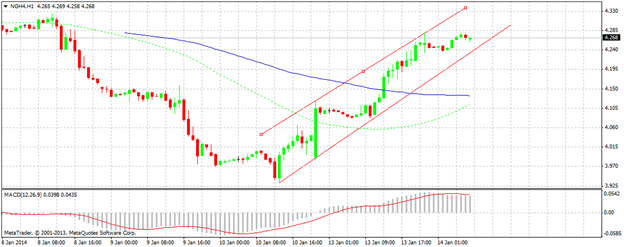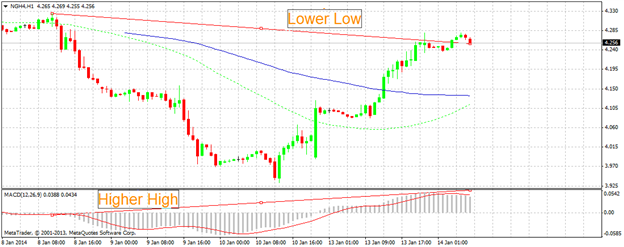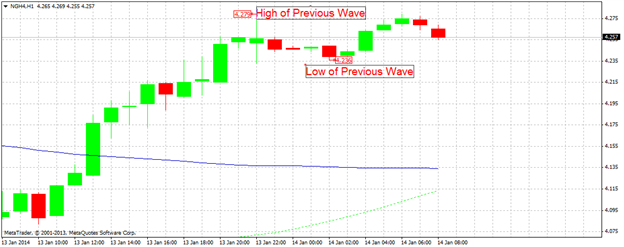Natural Gas futures for February delivery rose to $4.279 per Million British Thermal Units (MBTU) on Tuesday, the highest level in sixteen months, amid concerns that cold weather may have reduced the US heating oil stockpiles to a record low.
Gas futures surged more than 5.5 per cent during Asian session today, the biggest rise since late 2012, on speculation that a report by Energy Information Administration (EIA) which is due on January 16 may reveal that supplies slumped to 303 billion cubic feet at the end of last week, which would be more than 285 billion, the lowest level recorded on December 13. It is pertinent that temperatures are likely to remain below average level in the eastern United States from January 18 to January 27, according to a report by MDA Weather Services.
At the time of writing gas futures are being traded at $4.25 / MBTU, in an upward slope channel as shown below, immediate support is seen at $4.23, current channel support, ahead of $4.13, hourly 100 MA, and then $4.11, hourly 55 MA.

Gas may found resistance in short term around $4.342, current channel resistance.
It is also to be noted that significant positive divergence may be noted with MACD in short term as charted below;

This clearly indicates that natural gas futures may print new highs in near future. Relative Strength Index (RSI) is currently in oversold territory which means some correction is expected before further upward movement.
The correction should however be restricted above $4.236, swing low of previous wave, and then Gas price should resume upward movement with a new high above $4.27 as shown in the following chart;

Contrary to above mentioned scenario if we see a Lower Low (LL) on hourly chart, it would expose weakness in ongoing bullish momentum thus pointing to a downside risk.
Earlier gas futures suffered heavy losses last week due to hawkish FOMC minutes, poor non-farm payrolls and a rise in temperature at the end of week.
Gas stockpiles were recorded 2.817 trillion cubic ft on January 3, 10% percent down from 5-year average and about 15% percent less than previous year’s weekly supplies, according to a report released by EIA. Investors are seen very cautious and reluctant in keeping the short positions opened before a very crucial storage report due on Thursday.
Temperature fell to the lowest level in 21st century on January 7 in some US states, according to a report by weather department. The report forecasts 18 degrees Fahrenheit temperature in New York on January 19, 9 degrees less than the average. Similarly mercury may come down to 15 degrees Fahrenheit on the same date, which would be 8 degrees less than the normal temperature, the weather report added.
In addition Federal Open Market Committee (FOMC) meeting is also scheduled on January 29 in which policy makers are expected to consider more tapering in monthly bond purchase program after a labor department report showed that the jobless rate in the US has slumped to 6.7%, the lowest since 2008.
original source

 By
By 



